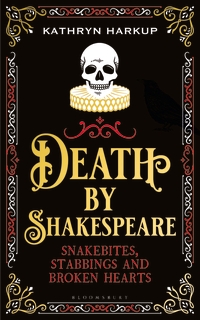I write books that mix fiction with fact, history, biography and science.

There may not be many writers combining science and literature, but there are plenty who blend genres or integrate wide-ranging influences and sources to form their work. This is how I try to wrangle a hodgepodge of background research into a single book. It’s by no means a definitive guide but maybe it will resonate with those trying to wrestle multiple themes into one finished piece.
The first thing I try to do is keep it simple. The books I write all have a simple premise - the poisons Agatha Christie used in her novels, the scientific background of Frankenstein, or death and Shakespeare. But, to arrive at what I hope are coherent and easy to understand books, involves researching a huge range of material from diverse genres - plays, novels, history books, biographies, science books, academic papers and more.
The first thing I do is a lot of planning. Part of writing a proposal for a non-fiction book is briefly describing the book chapter by chapter. This is how I start to organise my book. If I am trying to balance lots of different sources of information, the structure of the book itself needs to be very simple and follow a logical sequence. I found this particularly difficult when writing about Mary Shelley and Frankenstein. I wanted to talk about this remarkable author, the important scientific milestones that occurred during her life as well as the novel and how Shelley incorporated her scientific understanding into a fictional work. It could easily have ended up being a mismatch of information that a reader would struggle to follow. What I think helped most was deciding to keep everything strictly chronological.
As I plan out each chapter areas of research will become obvious. For example, if I’m going to write about murder, I need to read a book or two about forensic pathology. As I read more books I find references to other books that might be useful. Before long I have a sizeable reading list.
I read a lot, and I tend to read whole books, not just key bits I think might be relevant from scanning the index. It gives me a better understanding of context and sometimes gives me ideas for other books I might like to write one day.

On top of reading, I make a lot of notes. Toxicology books will be bristling with sticky notes marking the pages where particular poisons are discussed. Biographies will look like multicoloured paper hedgehogs where I’ve found interesting facts. I then go back and hand write these key sections into notebooks. It can be time consuming but it slows me down and makes me think. Handwriting notes has been shown to produce better retention of information than typing, and with a lot of disparate facts rattling around inside my head, it makes it easier for me to make connections and see similarities. It also makes me more ruthless. To stop my hand from cramping I only include things I think are relevant.
There are a few downsides to handwriting notes, apart from the time it takes. I sometimes spend time writing notes on things that seemed great at the time, but will be edited out later because they are too much of a distraction. I have lots of notes on zombie kittens and Macbeth riots that sadly never made it into the finished book.
For the actual writing process, the first stage for me is to pour all the ideas out of my head and on to the page. I also scan through my notes to type in anything I think might be relevant. This stage is very chaotic, there are gaps, incomplete sentences, notes to myself and question marks all over the place. Slowly, patterns emerge that will hopefully get across the concepts I want to present to the reader. Irrelevant bits can be shifted to other chapters, saved to a ‘manuscraps’ folder in case they might be useful one day, or, if I’m feeling really brave, deleted. Then I write and rewrite the chapter until I think it is readable by someone else.
I then get several kind and long-suffering friends and relatives to read what I have written and give feedback. I want non-scientists to tell me if they understand the science. Those who are unfamiliar with Shakespeare or British history can tell me if I need to explain the plots of his plays better. All of them can tell me what was fun, boring, confusing or distracting. The final stage, before submitting my manuscript, is smoothing out the wrinkles and papering over the cracks pointed out in the feedback. In short, gather lots of information then refine, reorganise and rewrite until it feels right.
Kathryn is a chemist and author who writes and gives regular public talks on the disgusting and dangerous side of science. She has written three books, A is for Arsenic: The Poisons of Agatha Christie, Making the Monster: The Science of Mary Shelley’s Frankenstein and Death by Shakespeare: Snakebites, Stabbings and Broken Hearts.
Comments